Touring 1919 General Strike History in Winnipeg, Canada
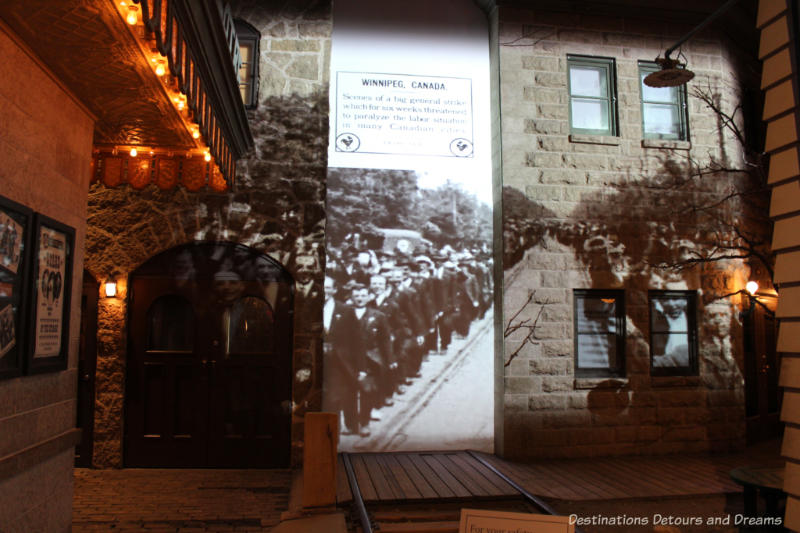
A number of attractions in Winnipeg, Manitoba, Canada offers visitors the opportunity to explore the history and stories of the 1919 Winnipeg General Strike
(Last updated May 2023)
For six weeks in 1919, the city of Winnipeg, Manitoba, Canada was gripped by a bitter labour dispute that paralyzed and polarized the city. The strike was a big news story at the time dominating local papers and bringing reporters from across the country to Winnipeg. The strike remains a significant point in Winnipeg’s history and in Canada’s labour history. 2019 marked the 100th anniversary of the 1919 General Strike. Scheduled events commemorating the strike included talks, presentations, a parade, a concert, staging of the play Strike! The Musical, and the release of a movie version of that play. Beyond specifically scheduled events, there were a number of places tourists and locals can visit to learn more about the strike and its legacy. Those sites are highlighted in the remainder of this article. Although the year of commemoration is now over, these sites can still be visited to gain a better appreciation of the strike and its impact.
Table of Contents
1919 Winnipeg General Strike Overview
1919 Marquee – A Monument
Exchange District Strike Walking Tours
Urban Gallery at Manitoba Museum
Dalnavert House Museum
Winnipeg Police Museum
Canadian Museum for Human Rights
Bloody Saturday Public Artwork
Labour Movement Mural
1919 Winnipeg General Strike Overview
First, a brief recap of the strike to set context. 1919 was a time of tumult and anxiety. The 1917 Russian Revolution created a fear of Bolshevism taking over the world. World War I had just ended in November 1918. A Spanish influenza outbreak in the winter and spring of 1918-1919 killed more than 800 people in Manitoba. The post-war economy was struggling. There was rampant inflation. Some factories shut down. Workers were denied raises and working conditions were dismal. Traumatized returning veterans found their jobs no longer existed or had been filled by the large immigrant population.
A general strike, called to support building and metal workers already on strike for two weeks, officially began at 11:00 am May 15, 1919 when between 25,000 and 30,000 workers walked off their jobs. Unofficially, it began several hours earlier when the provincial telephone operators, known as Hello Girls, didn’t show up for their shifts. Stores and factories closed. Milk, bread, and ice deliveries stopped. Even the streetcars stopped running for a time. Shortly after the strike began, the Strike Committee issued special permits to allow certain businesses to remain open.
Businessmen and the city’s elite formed the Citizens’ Committee of 1000 to fight the strike. They blamed the strike on Bolsheviks and foreign agitators and claimed the real aim of the strike was revolution. The city’s three daily newspapers were shut down for about a week at the beginning of the strike. They became part of the strike battleground when they resumed printing with largely anti-strike biases. Two new dailies emerged, one supporting the strikers and one against them.
As the strike progressed, the once peaceful demonstrations began to see more and more confrontation, culminating in the events of Bloody Saturday. On June 21, 1919, thousands of strikers and their sympathizers gathered in downtown Winnipeg in a silent parade to protest the arrest of strike leaders. Crowds and police clashed. In the confrontation that followed, two people were killed and at least 30 injured. Angry protesters turned over a street car in front of City Hall and set it on fire. Fighting spilled into a nearby side street, which became known as Hell’s Alley after a ten-minute conflict resulted in twenty-seven casualties.
During the strike, as many as 35,000 workers walked off their jobs. The city’s population at the time was about 175,000. On June 26, 1919, fearing more violence, strike leaders called off the strike. After forty-two days on strike, strikers returned to work without gaining additional rights or improved working conditions. Some lost their jobs. Seven strike leaders received jail sentences. What must have felt like a failure at the time is now credited with laying the seeds of the modern Canadian labour movement. A provincial inquiry deemed that the strike did not have revolutionary motives, but was indeed a protest against poor working conditions and wages. Some strike leaders went on to take elected office in government.
I haven’t covered all of the events of the strike and there are many topics that could be explored more deeply and indeed have been in the numerous books and papers written about the 1919 Winnipeg General Strike. Topics like the political atmosphere, the impact on everyone in the city, conspiracy theories, the divide between the rich and the poor, the fear of foreigners, the role of the press, the strike’s legacy, and the labour movement in general. The following sites will provide more information and insight into some of the events, the human stories, and the issues.
1919 Marquee- A Monument to the Winnipeg Strike
In November 2017, a monument commemorating the 1919 Winnipeg General Strike sits on the corner of Market Avenue and Lily Street in the East Exchange District. The billboard style art piece of weathering steel has an industrial look that seems fitting for a labour event marker. The location is significant because it is next to what was once Hell’s Alley and close to other key strike locations.
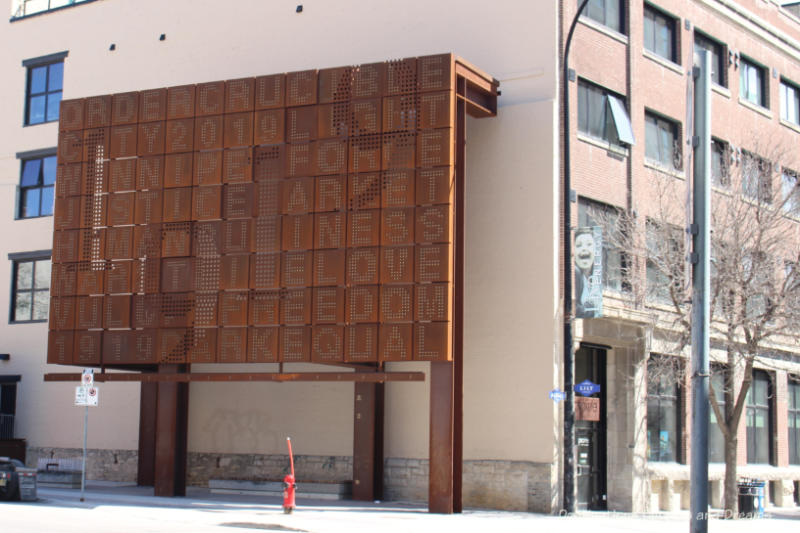
A smaller board beside the one in the photo features a capsule description of the strike and a map of relevant strike locations in the surrounding area. The map highlights how this section of the city was at the heart of the strike, but I don’t think it’s a good guide to use to explore the locations unless you know strike history and are somewhat familiar with the nearby streets. The map is crude. The significance of some locations is not explained and there is nothing to indicate which landmarks still exist. A guided walking tour may be a better way to explore.
Exchange District Walking Tours
The Winnipeg Exchange District BIZ offers a variety of historical guided walking tours from May through August. One of those tours focuses on the 1919 Winnipeg General Strike.
The Winnipeg Exchange District is a National Historic Site featuring North America’s largest and best-preserved collection of heritage buildings built between 1880 and 1920. This was the heart of the city in 1919 and the scene of significant strike events. Walking through the district is like taking a step back in time.
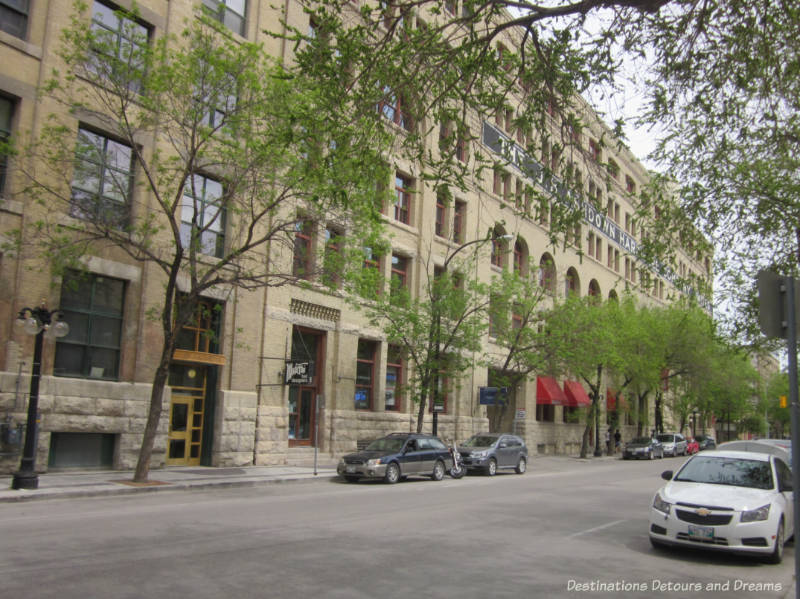
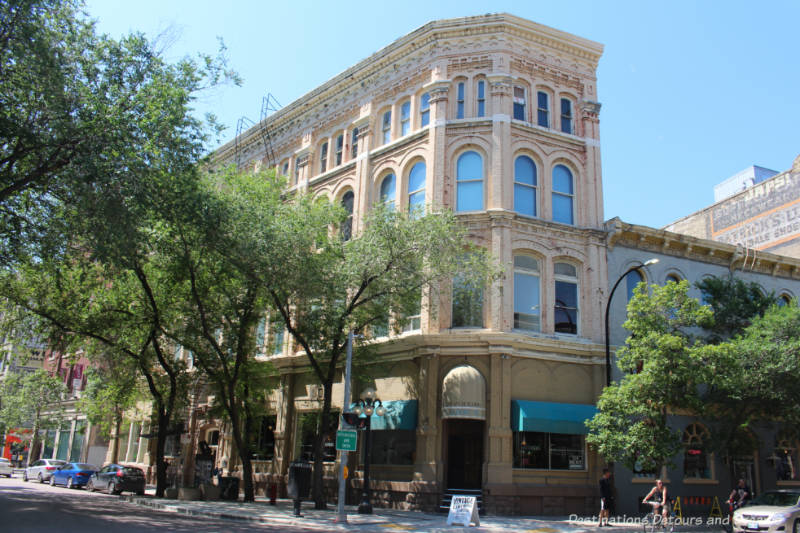 The former home of the Telegram newspaper
The former home of the Telegram newspaper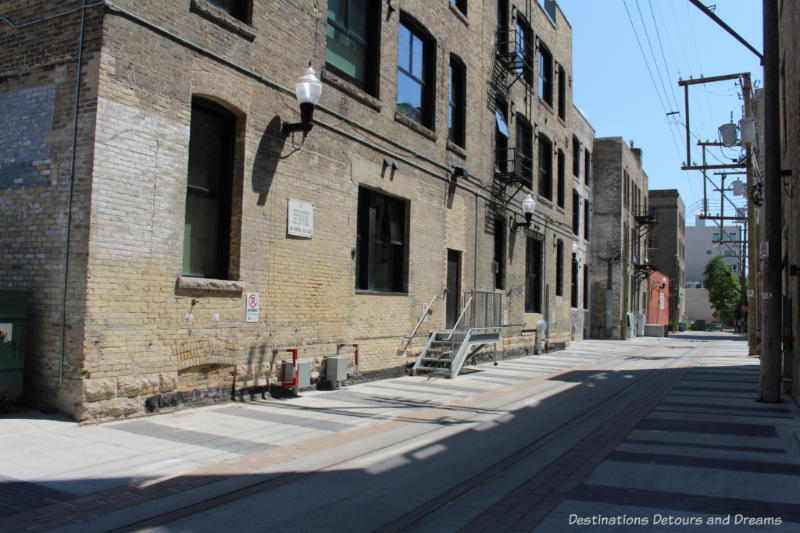 Hell’s Alley
Hell’s AlleyToday the Exchange District contains galleries, studios, unique shops, and over 50 restaurants. In addition to the historical walking tours, the Exchange District BIZ offers food tours in July and August.
Winnipeg Exchange District historical walking tours run May through August. The regular hour-long Strike-themed tour takes you to sites of significant strike events. The ninety-minute extended tour takes you to those same locations and provides information of what life was like in Winnipeg leading up to the strike and what happened in the years that followed.
The Manitoba Museum
The Manitoba Museum, located in the East Exchange District, near what was once the James Street Labor Temple, headquarters of the 1919 Strike Committee, showcases natural and human history in the varied landscapes of Manitoba. The Urban Gallery, which typically depicted Winnipeg in 1920 was moved back in time one year for the exhibition Strike 1919: Divided City, which ran from March 2019 to early 2021. Here are a few highlights of that exhibition, which is no longer running. Other information about the strike can still be found at the museum in its Winnipeg gallery.
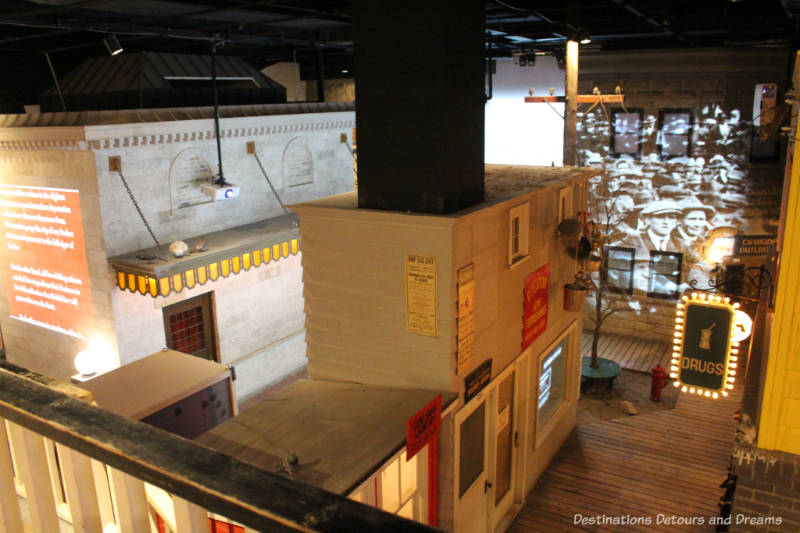
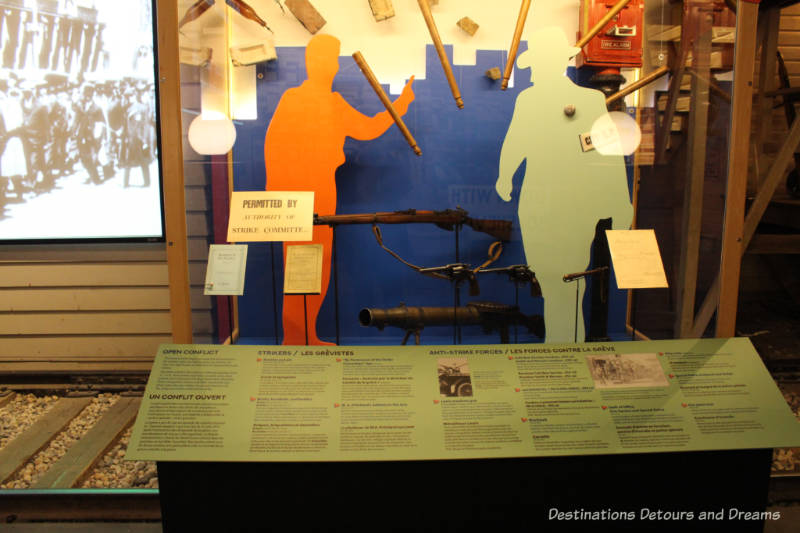
Information about the strike is provided through text and images on placards augmented with authentic strike artifacts
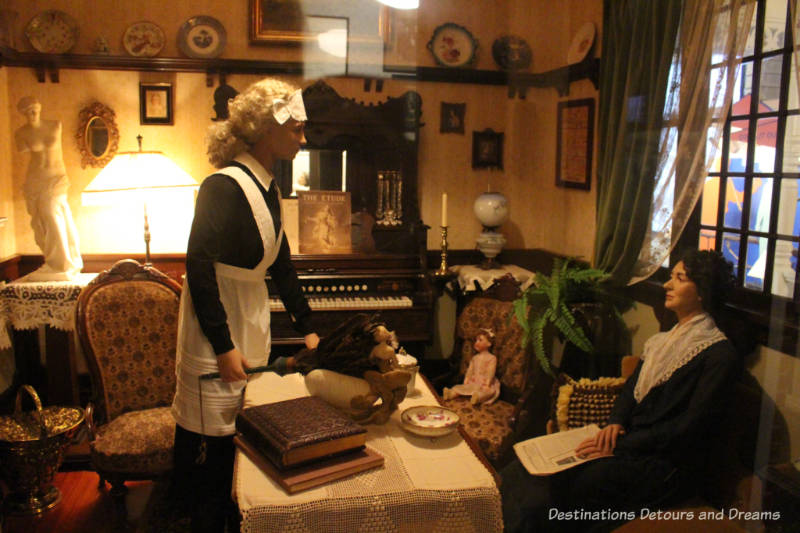
Conversations between “talking” mannequins, whose recorded “voices” can be activated by the push of a button, provide insight into the divisions within the city. In one of those conversations, a dentist’s wife and her maid politely discuss the strike from differing perspectives. Another conversation takes place between an immigrant striker and a veteran about to join the Special Constables fighting the strike. They are staying in adjacent rooms of the same hotel.
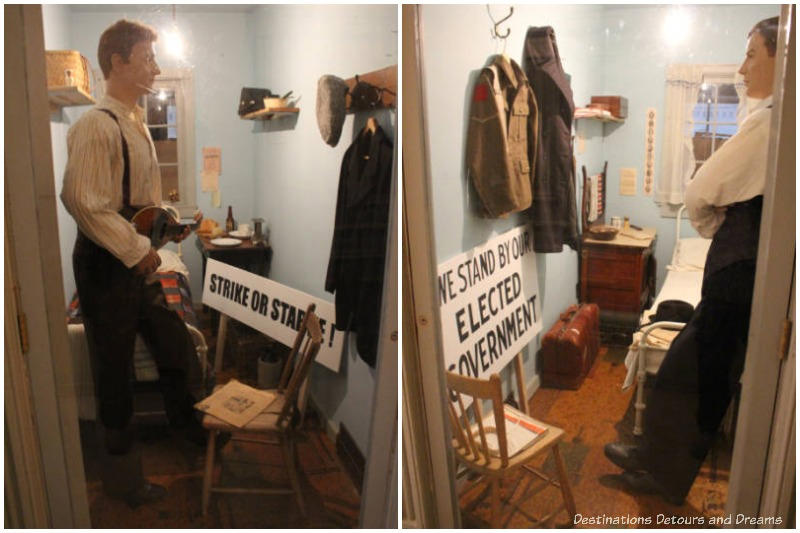
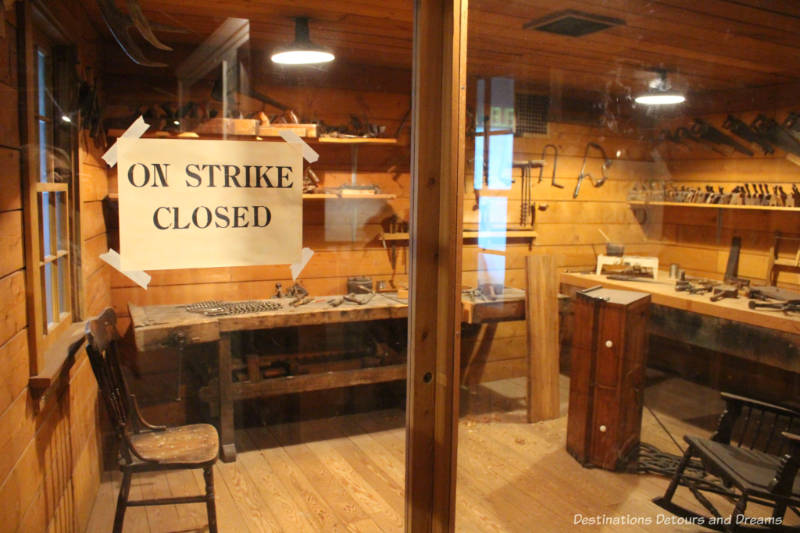
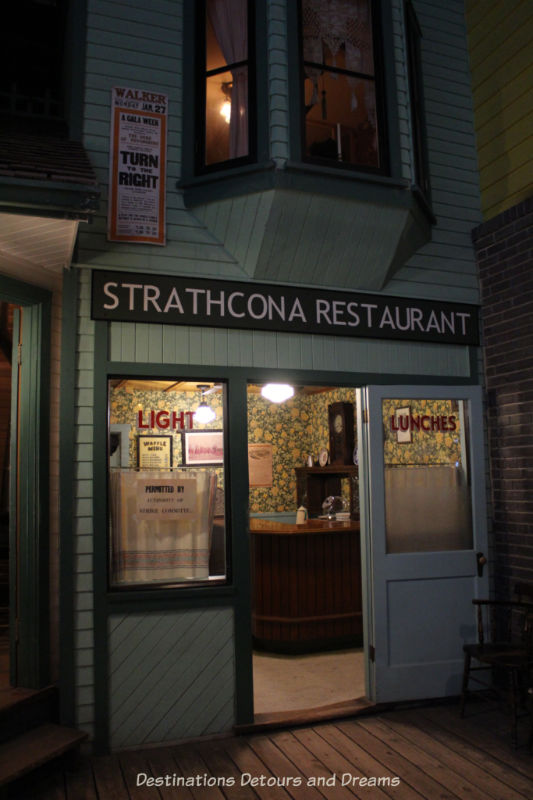 Other businesses are open with a Permitted by Strike Committee sign in the window
Other businesses are open with a Permitted by Strike Committee sign in the window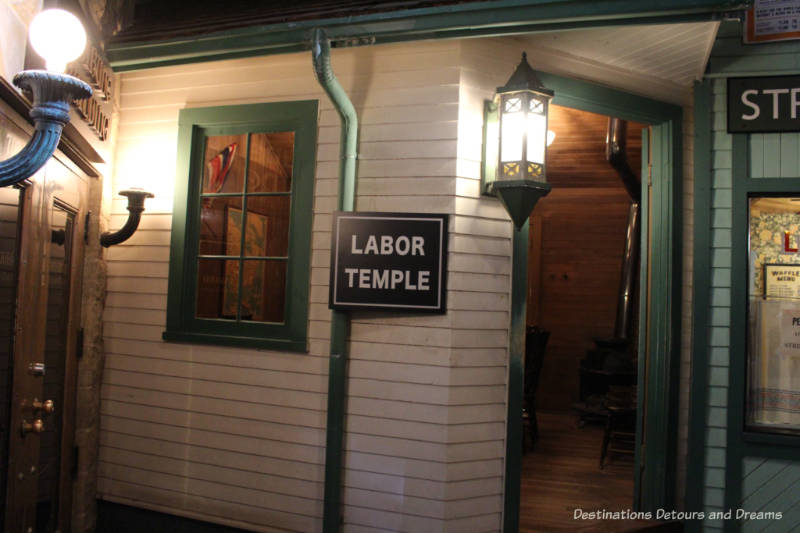
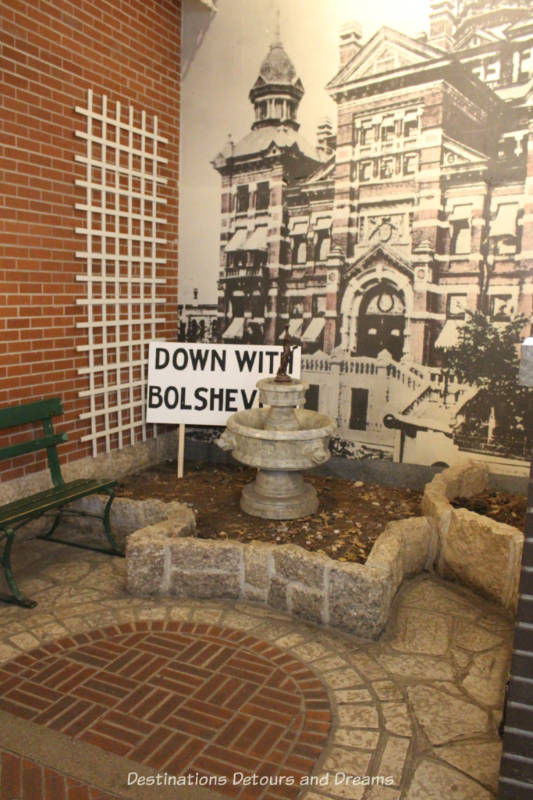
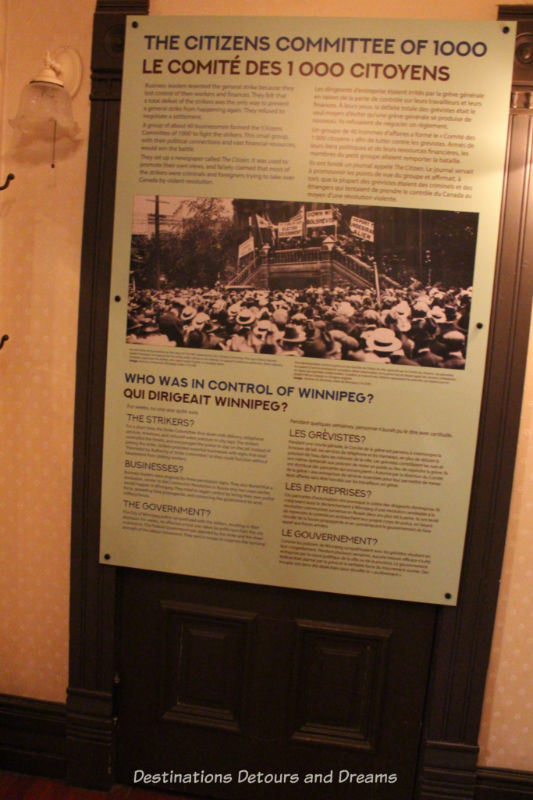
The exhibit, like the strike itself, poses social questions
Check the Manitoba Museum website for open hours, which vary by season.
Dalnavert House Museum
Dalnavert Museum is a Victorian house, built in 1895 for Sir Hugh John Macdonald, who was a Manitoba Premier, a Police Magistrate, a lawyer, and son of Canada’s first Prime Minister Sir John A. Macdonald. The house has been renovated and decorated with period furnishing to create a sense of “a day in the life.” From May 3, 2019 to September 29, 2019, Dalnavert ran a special exhibition STRIKE 1919: Our Cause is Just. Although that exhibition is no longer running, touring the house may give you an idea of how one side of the divided city lived.
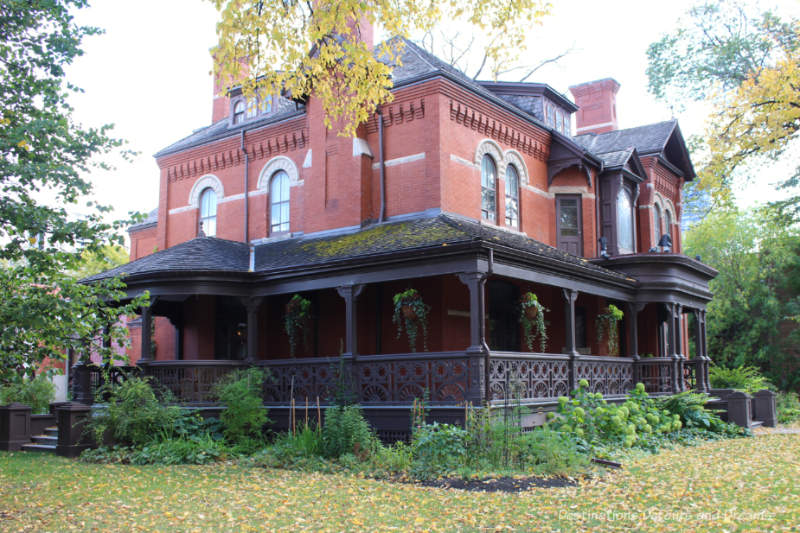
As police magistrate and member of the Board of Police Commissioners, Macdonald was concerned by attempts to unionize Winnipeg’s police force. He saw the 1919 Winnipeg General Strike as a revolutionary movement bent on instilling a soviet-style government. He believed foreigners were responsible. On June 6, he moved that the police commission hire 3,000 special policemen and equip them with batons.
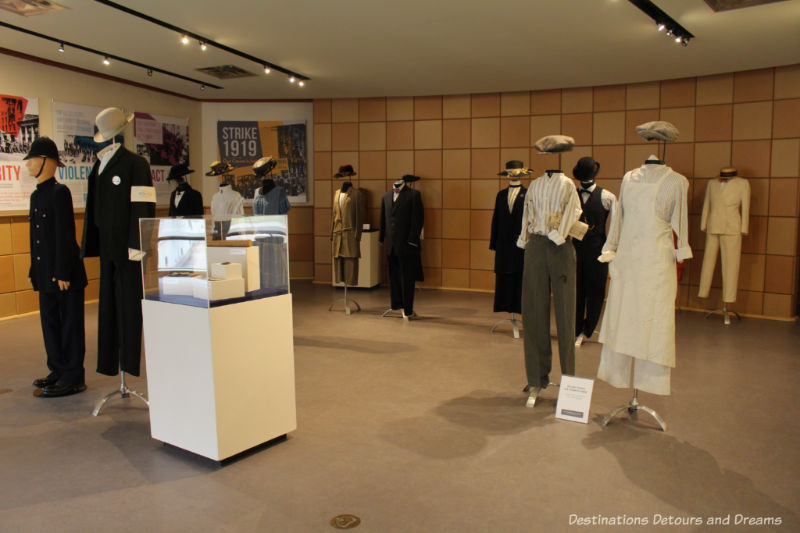
The STRIKE 1919:Our Cause is Just exhibit featured information about the strike, period clothing provided by the Costume Museum of Canada, a few artifacts from Dalnavert’s collection, and panels with information and thought-provoking questions about present-day struggles and protests.
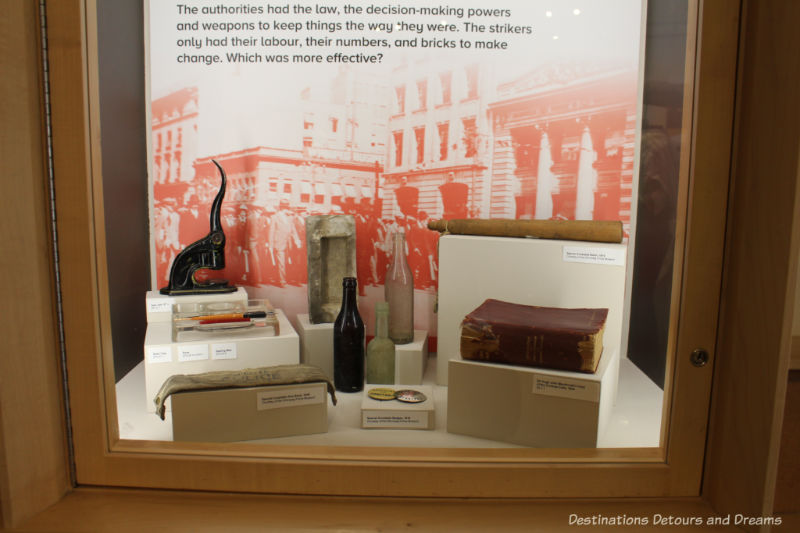
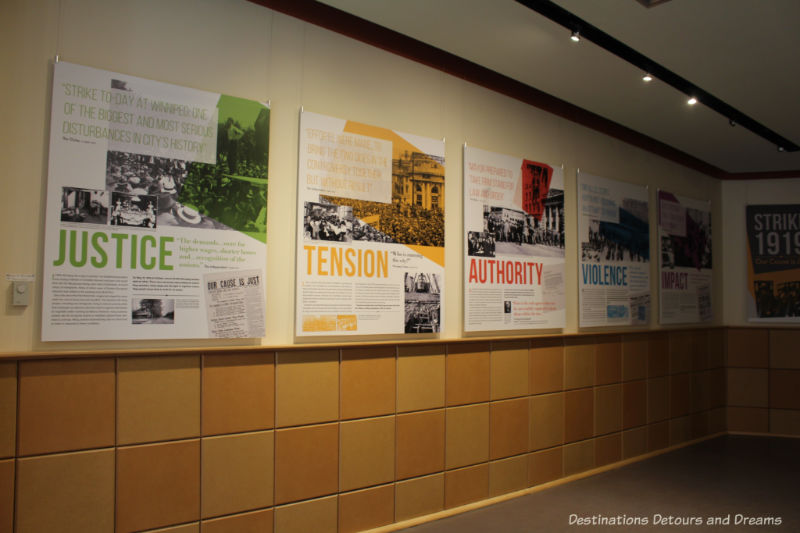
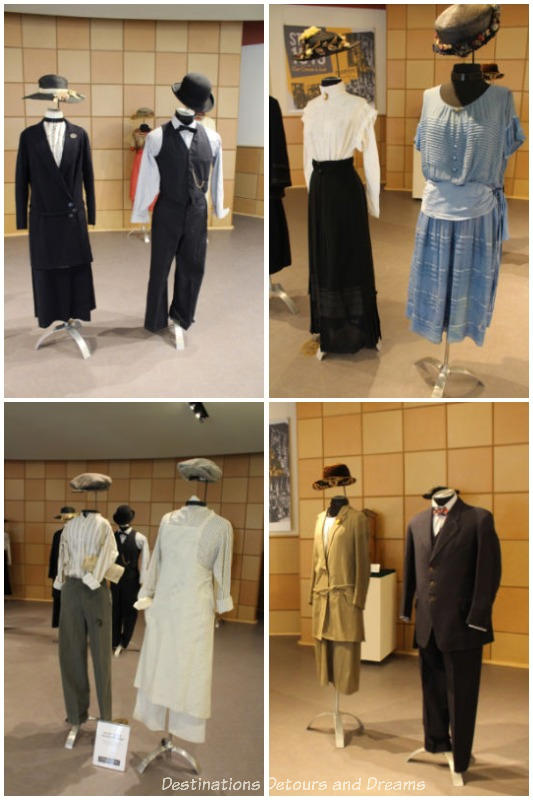
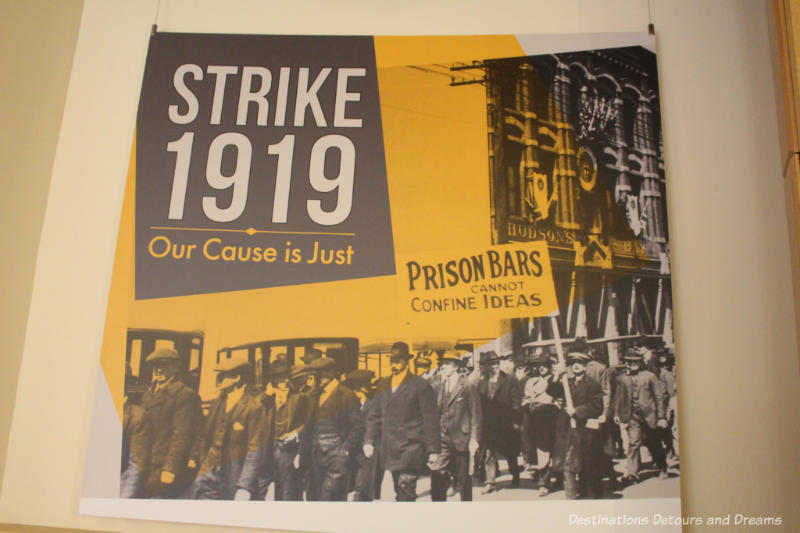
Dalnavert is open Wednesdays to Sundays from noon to 4 pm.
Winnipeg Police Museum
Exhibits at the Winnipeg Police Museum tell the history of the Winnipeg police force, policing in general, and of the city. One of the exhibits featuring both Winnipeg and police history is on the 1919 Winnipeg General Strike.
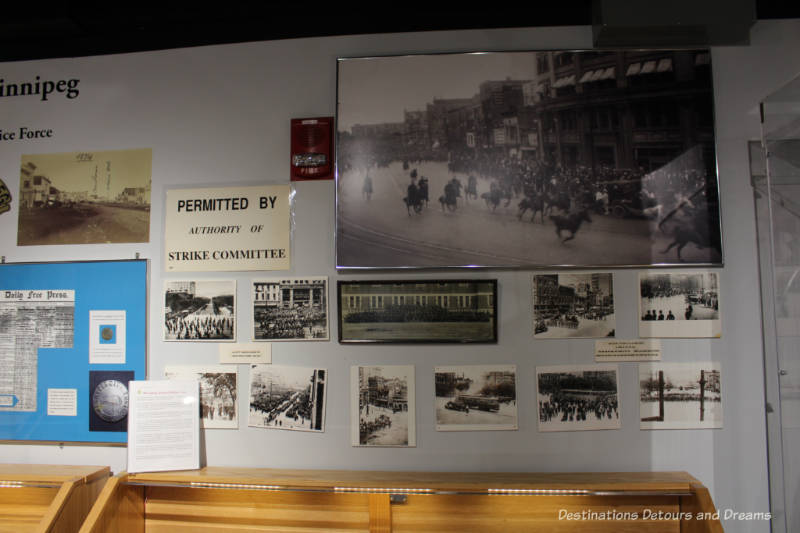
Members of the Winnipeg Police force had voted in favour of the strike, but remained on duty when it started at the request of the Strike Committee. On June 9, most of the Winnipeg Police force were fired for refusing to sign a loyalty agreement prohibiting participation in any union or sympathetic strike. The City called on the North West Mounted Police, military troops, and approximately 1,400 “Special Constables” to patrol the streets.
The Winnipeg Police Museum is open Tuesdays through Fridays from 10 am to 3 pm. Admission is free.
Canadian Museum for Human Rights
One of the exhibits in the Canadian Journeys gallery at the Canadian Museum for Human Rights (CMHR) is about the 1919 Winnipeg General Strike. The exhibit is not large and is just one of many stories in the gallery, but it includes an overview of the strike, a few strike artifacts, and a video presentation about the strike.
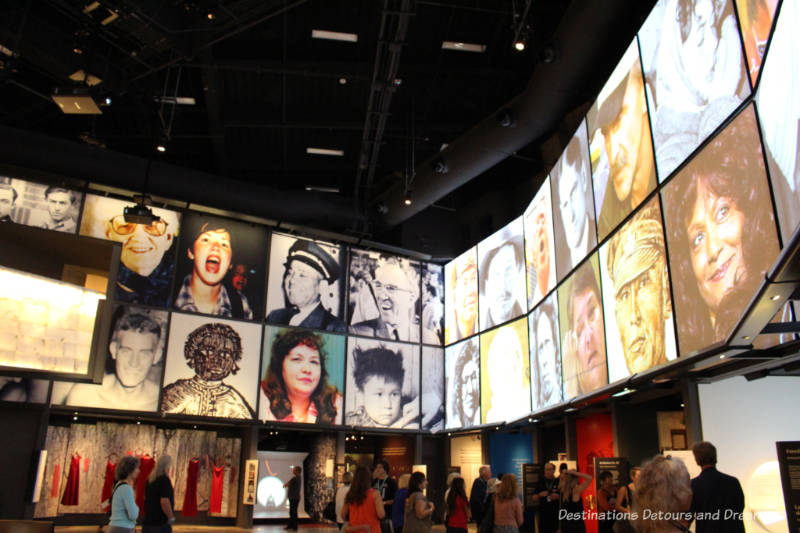
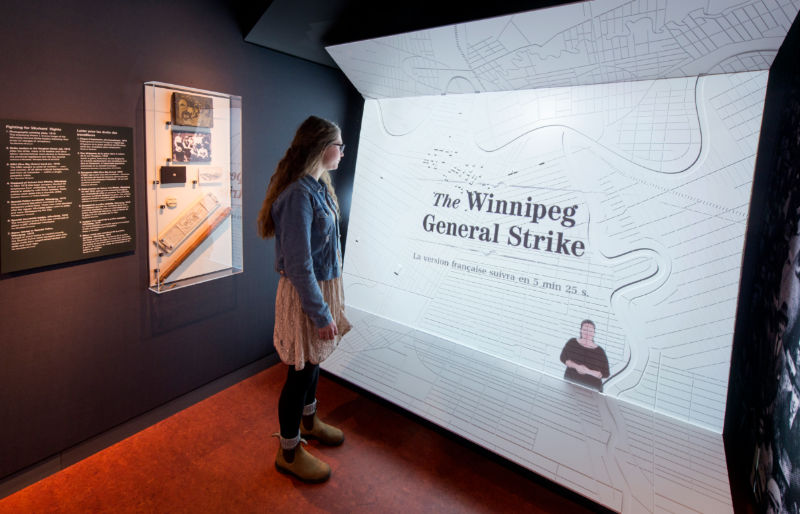
The 1919 Winnipeg General Strike is not likely to be the main focus on a visit to the Canadian Museum for Human Rights, but the strike story, other stories in the Canadian Journeys gallery, and the exhibits in other galleries make the museum well worth visiting. CMHR is at the top of lists of things to see in Winnipeg.
Bloody Saturday Public Artwork
A photograph of a street car being tipped in front of City Hall on Bloody Saturday is one of the most recognizable images of the 1919 strike.
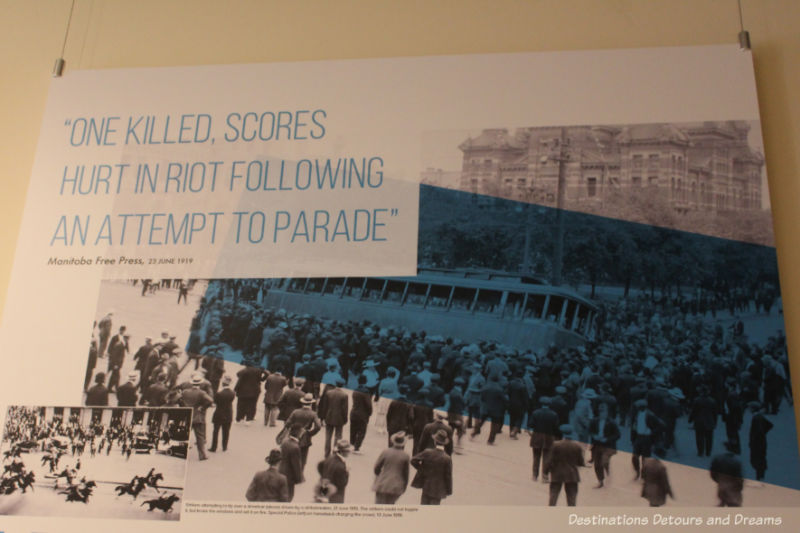
The streetcar, run by replacement workers, approached City Hall where strikers and supporters had gathered to protest the arrest of strike leaders. The angry crowd surrounded the streetcar, rocked it side to side, smashed windows, and set it on fire. No one was in the streetcar when it was set on fire, but subsequent violence when police and special constables arrived resulted in two deaths and ultimately led to strike leaders calling off the strike.
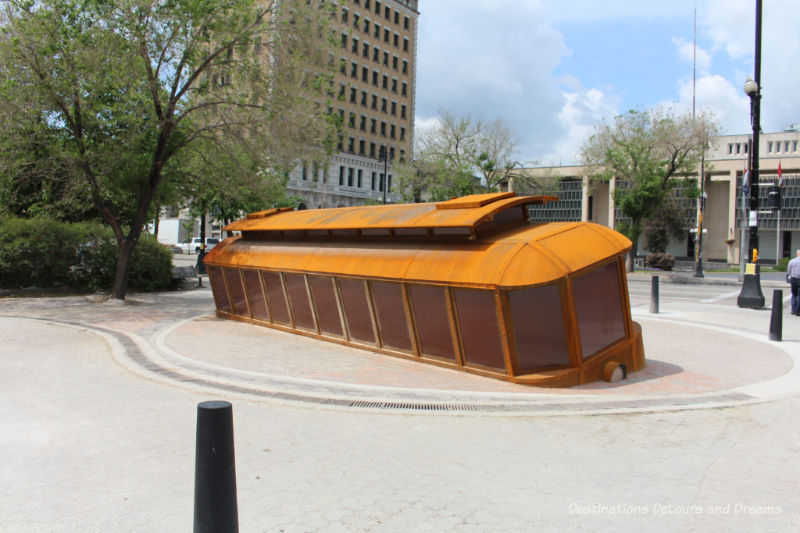
On June 21, 2019, the hundredth anniversary of Bloody Saturday, a tilted streetcar sculpture was installed in Pantages Plaza on Main Street near the site where the streetcar incident occurred. The Winnipeg Arts Council commissioned the artwork. Artist and filmmaker Noam Gonick collaborated with sculptor Bernie Miller on the project. Miller died in 2017, shortly after the design had been completed. Titled Bloody Saturday, the sculpture is built from steel and glass and is illuminated from within at night.
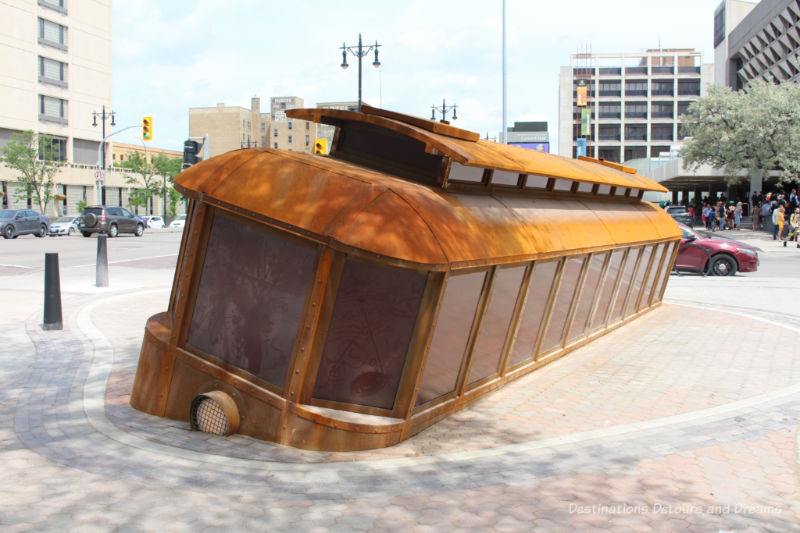
Labour Movement Mural
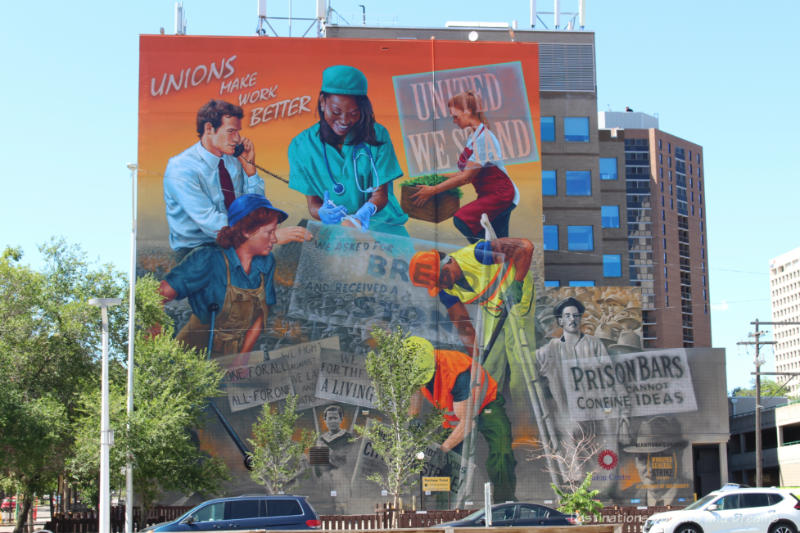
In July 2020, a mural representing the history of Manitoba’s labour movement from the 1919 General Strike to present day was unveiled on the side of the Union Centre building on Broadway at the corner of Smith. The mural stands several stories tall and was created by mural artist Charlie Johnston.
Never miss a story. Sign up for Destinations Detours and Dreams free monthly e-newsletter and receive behind-the-scenes information and sneak peaks ahead.
PIN FOR LATER
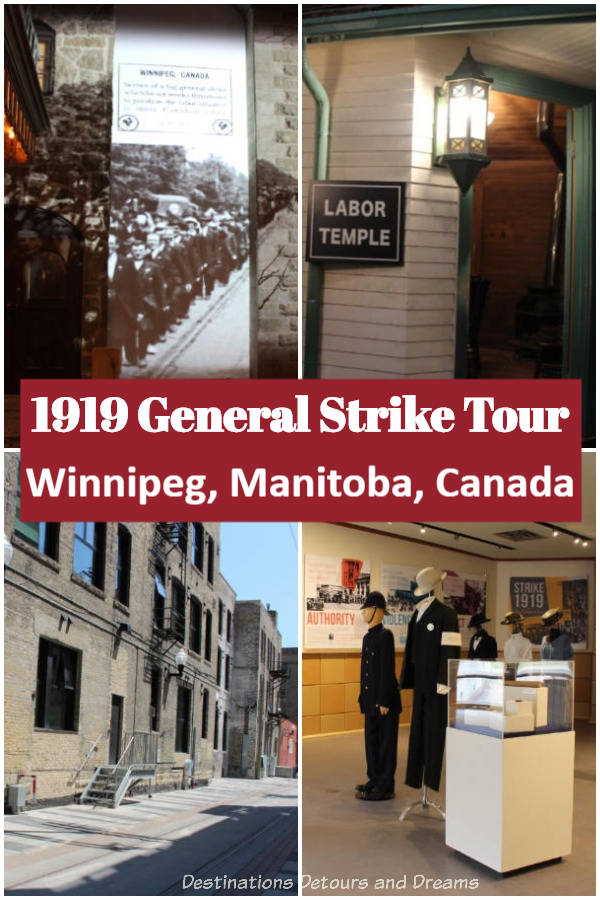

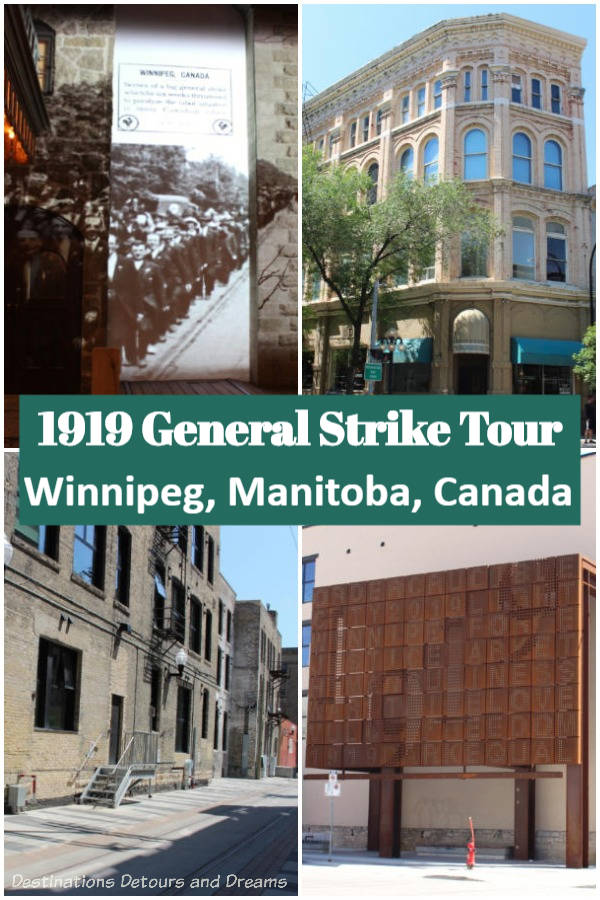
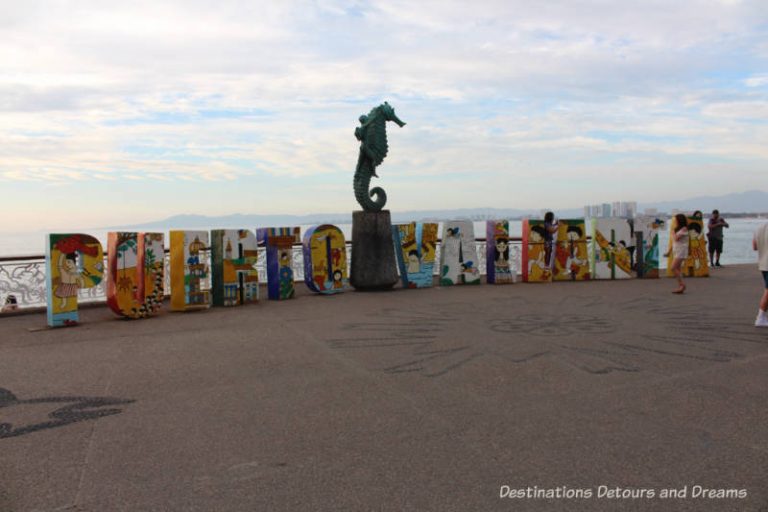
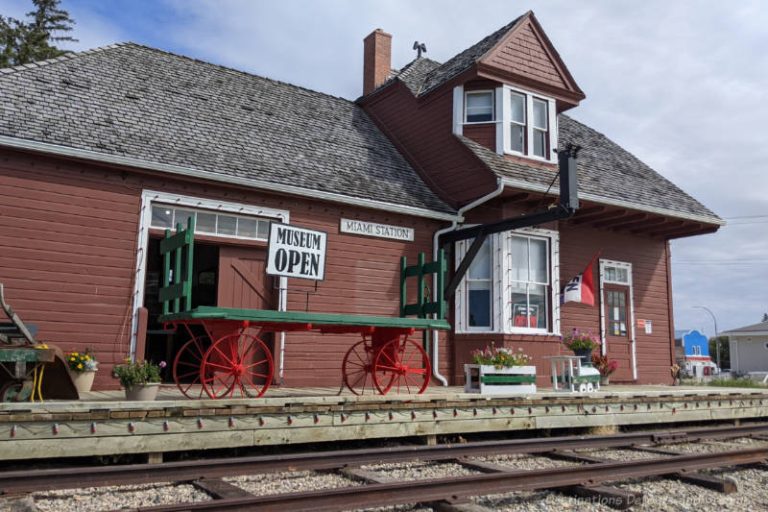
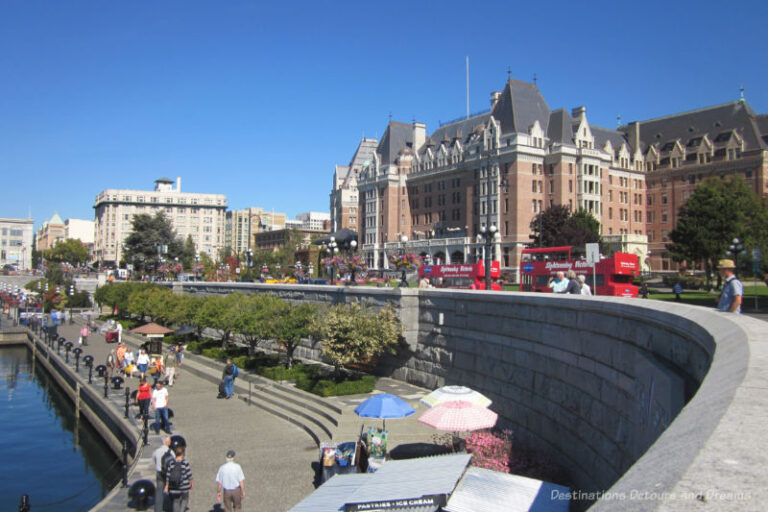



Excellent post, Donna. I’m sending the link to a half dozen international visitors we’re hosting in Winnipeg this summer to give them some background on this watershed time in Winnipeg.
Thanks Deb. With all the things going on to commemorate the 100th anniversary of the strike, visitors this summer are likely to encounter more strike history and events related to it than in other years.
Found the story of the general strike really interesting. Love the fact that the “hello girls” got it rolling. Filmmakers take note.
Ken, a musical play about the strike called Strike! The Musical premiered in 2005. It used a love story between a Ukrainian-Canadian labourer and his Jewish neighbour to tell the larger social justice story. A movie version called Stand! was filmed in Winnipeg last year and is scheduled for release this fall. But there are so many stories within the overall strike story that would make great films, including that of the “hello girls.”